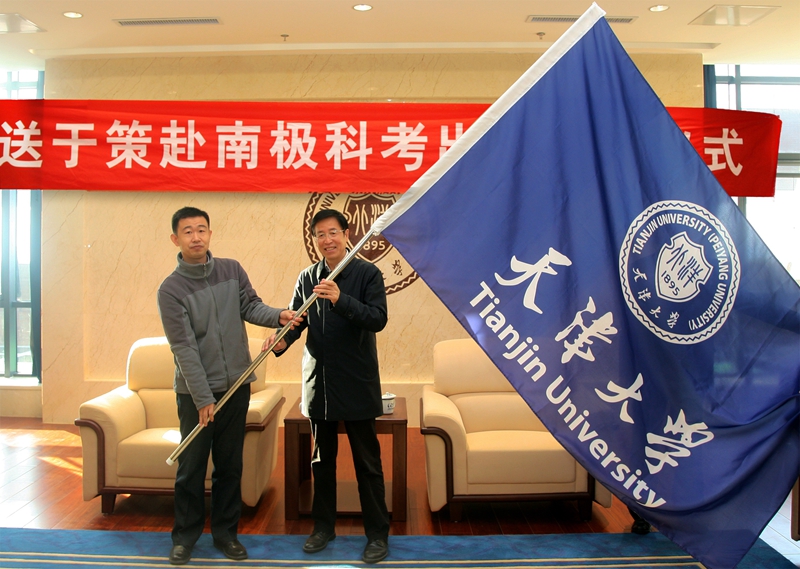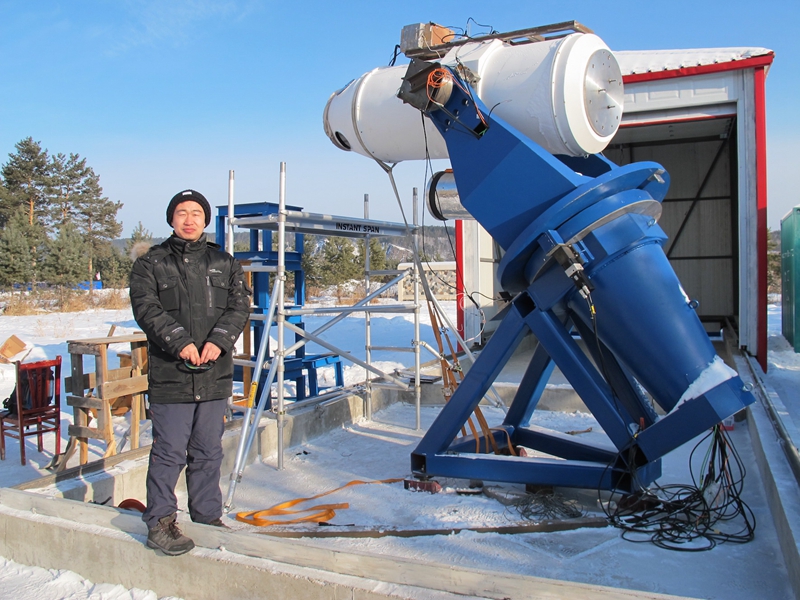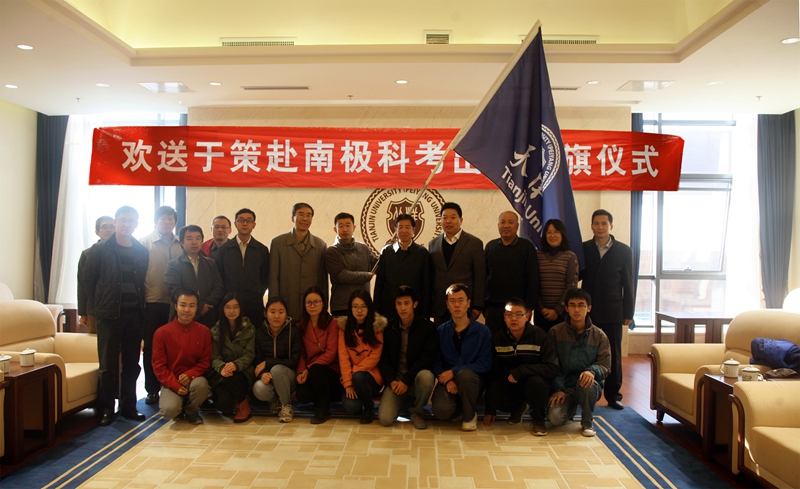
On the morning of November 2, 2015, a special expedition ceremony was held at the Peiyang Campus of Tianjin University. Associate Professor Yu Ce of the School of Computer Science and Technology, who will set out with China’s 32nd Scientific Expedition to the Antarctic, was awarded a flag of Tianjin University by the President, Professor Li Jiajun.
As a core member of the Astronomy Group of the Scientific Expedition to the Antarctic, Associate Professor Yu will be at the Antarctic Kunlun Station, the highest point of the Antarctic, to implement the installation, upgrades and maintenance of the observation data analyzing and processing system of the Antarctic Survey Telescopes (AST3) and the equipment of energy secure platforms and inspection meteorological station. The flag of Tianjin University will be unfolded at the Antarctic Kunlun Station and will indicate to the world Tianjin University people’s grounded attitudes and dedications to serving the major strategic needs in the Chinese astronomical observation field.
Tianjin University Provided the Super Brain for the AST3 Used in Chinese Astronomical Observation

"The Antarctic is the best astronomical observation site on earth. It has a clean and stable atmosphere, and provides a high degree of visibility, and allows for an endless and continuous observation during the polar nights. It has become the arena to carry out astronomical observations for the world. Many new discoveries have a significant international influence”, Associate Professor Yu said. Associate Professor Yu is from the National Astronomical Observatories of the Chinese Academy of Sciences (NAOC)-Tianjin University (TJU) Astronomical Information Technology Joint Research Center at Tianjin University. AST3, whose first generation of observation data analyzing and processing system was developed by NAOC-TJU Astronomical Information Technology Joint Research Center, has provided data analyzing and processing systems for the Antarctic Survey Telescopes that China has installed since the 28th Scientific Expedition to Antarctic in 2011. During this expedition to Antarctic, Yu Ce will represent Tianjin University to install a new generation of AST3 observation data analyzing and processing system for the Antarctic Survey Telescopes.
According to Professor Sun Jizhou, the Director of the NAOC-TJU Astronomical Information Technology Joint Research Center, the Antarctic Survey Telescope, which can be used for 24 hours of uninterrupted observation, was installed in the "Dome A" observation point near the Antarctic Kunlun Station .Although the observation point has been identified by international astronomers in the world as the best ‘eye of the sky’, ‘the best’ always means ‘the most difficult’. As the ‘brain’ of the telescope, the processing and analysis of data would face many technical challenges. In the case of a harsh natural environment, low temperatures and pressure, as well as with no one on duty, the whole system is required to work steadily and continuously with no fault for a year or more.
Between the intervals of the continuous acquisition of the observatory images, the on-site data analyzing and processing of the previous images must be completed. To achieve this, the data processing system is claimed to have efficient analytical and processing abilities while the energy at the observation point is in short supply. Therefore, the whole system consumption including the storage system has to be reduced to a minimum. The remote transmission of the observational data throughout the country can only be transmitted by the "Iridium" Global mobile satellite communication system from US Iridium Company, whose bandwidth is low but price is high. Optimization for the operating mode and strategic scheduling are needed.
Sun Jizhou and Professor Yu Ce from the NAOC-TJU Astronomical Information Technology Joint Research Center at Tianjin University have joined in research on the Expedition to the Antarctic since 2008. Over the years, the team has been dedicated to the collaborative development of the hardware and software of the real-time processing system of the AST3 field observation data, transmission system of remote data, as well as special storage systems and other aspects. They have done an in-depth customization of the specific needs and hardware environment of the astronomical observation of the Antarctic. In meeting the stringent operating requirements the team has overcome a number of difficulties such as limited energy, and real-time processing.
Team members involved in the scientific expedition to the Antarctic must go through a rigorous selection and training process, including physical fitness tests. After passing all the examinations and assessments, Yu Ce was informed in September 2015, that he was qualified to be an official team member of the 32nd Scientific Expedition to the Antarctic.
A team of twenty-eight members will participate in the scientific investigation at the Antarctic Kunlun Station, of which only two astronomical expedition team members are included. Yu Ce boarded the research vessel that is expected to arrive at the Antarctic Zhongshan Station in early December, 2015. For the distance of 1,228 kilometers from the Zhongshan Station to the Kunlun Station, Yu Ce and his other twenty-seven colleagues can only travel by snowmobile. The team members will face the challenge of cold temperatures which can be thirty to forty degrees below zero, blizzards, no day-and-night when "polar days" occur and so on. They may also encounter the extremely dangerous Antarctic "whitening day." According to the plan, Yu Ce will not be back until April, 2016. He will spend his Spring Festival at the Antarctic this year.
Interdisciplinary Research Boosts Scientific and Technological Progress

"In the research field of astronomy, we are in fact 'layman' ", Professor Sun Jizhou said, when talking about the development of the AST3 observation data analysis and processing system for the astronomical research in the Antarctic Expedition. “But as researchers engaged in computer information and technology, when contacted by friends in the field of astronomy, we found that astronomy has a huge demand for the supporting role of information and technology; in the acquisition, transmission, processing, analysis and storage of spatial information and even the efficient and high-quality application of a variety of instruments and equipment resources that covers the whole astronomical research processes that is distributed around the world. It also contains many challenges that need research and breakthroughs in new technology of information applications." As a result, since 2004, Professor Sun Jizhou’s team have begun working with the National Astronomical Observatory and created a new field of "astronomical information technology" with an interdisciplinary model. They set up a joint laboratory in 2008, which has been updated in October, 2015 to the NAOC-TJU Astronomical Information Technology Joint Research Center.
These "laymen" from the field of information technology have completed astronomical research in cooperation with the National Astronomical Observatory over eleven years. Except for the development of the AST3 observation data analysis and processing systems for the Antarctic astronomical research, they have completed dozens of scientific research such as large data analysis of complex astronomical observation images and the construction of the "Chinese Virtual Observatory”, which is aimed at sharing and distributing information resources to astronomical facilities throughout the country. The team has achieved the Top Ten Excellent Award of information by the Chinese Academy of Sciences, eight copyrights for their software, five patents, and hundreds of published papers, and trained a new generation of master and doctoral students with expertise in astronomy and information technology.
In addition to joint research and development of astronomical information and technology, Professor Sun Jizhou and his team have expanded their perspectives in the field of cultural heritage protection and inheritance such as the monitoring of the Dunhuang frescoes disease, research on the information standards of antiquities, mapping and protection of ancient architecture, as well as recording data and inheritance of the traditional folk art, which have achieved initial successes. "Now when giving a class to the freshmen, I always tell them that we learn about 'computers', but we should never be limited to the perspectives of a 'computer'. We can reap the benefits in a new world if we apply the computer’s information technology with fields that intersect with other disciplines." Professor Sun Jizhou said," In the new era of the Internet, I believe that our road will become broader and broader. "